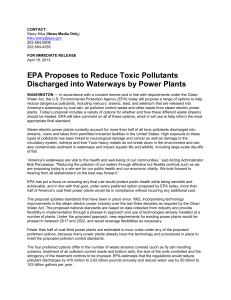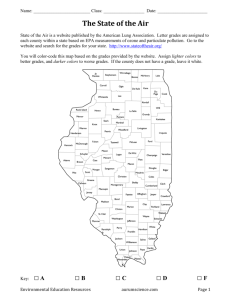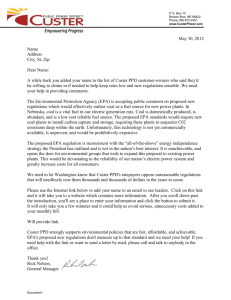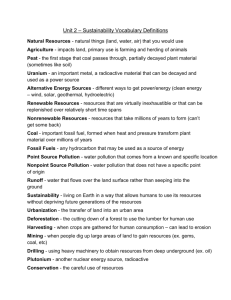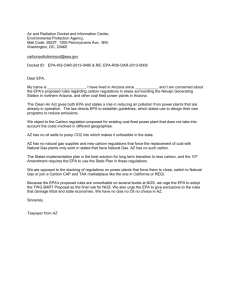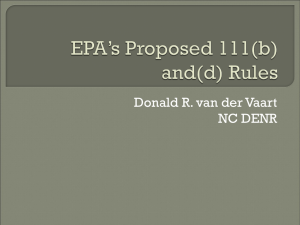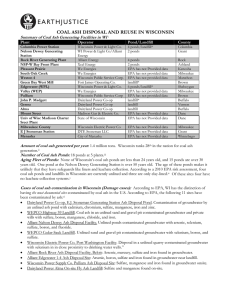Environmental Law and Coal
advertisement
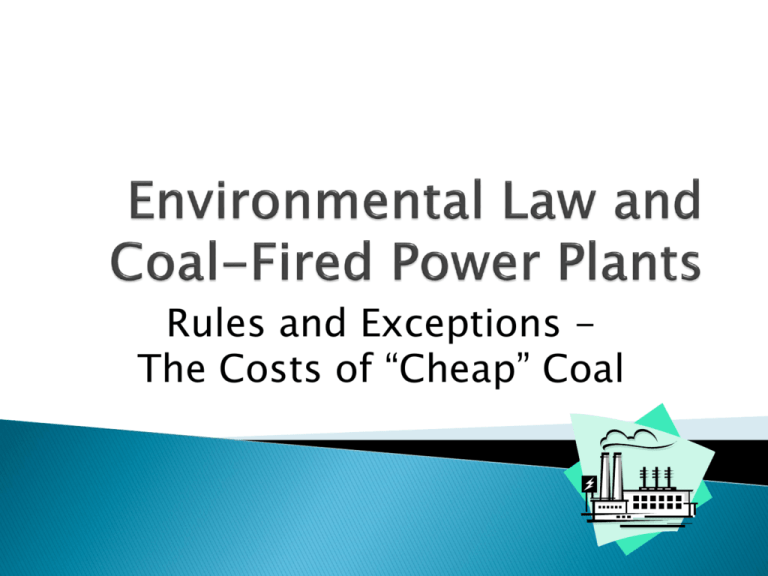
Rules and Exceptions The Costs of “Cheap” Coal Many plants pre-date modern environmental law Exemptions, lax regulation for decades Pollution costs externalized, borne by public and environment “War on coal”: ◦ Some exemptions ending ◦ Some new regulations – of varying stringency ◦ As more costs internalized, more plants closing Air Emissions Clean Air Act Water Pollution Clean Water Act ◦ Common pollutants (PM, SO2, O3, NOx, CO) ◦ Hazardous air pollutants (e.g., Hg) ◦ Carbon dioxide ◦ Cooling water – Intake system – harm to aquatic life Heat discharge – thermal pollution ◦ Coal ash – wastewater discharge Land and Groundwater Pollution ◦ Coal ash disposal – ponds and landfills EPA sets National Ambient Air Quality Standards (NAAQS) ◦ Standards must protect public health ◦ Ozone, sulfur dioxide, nitrogen oxides, particulate matter, carbon monoxide, lead ◦ Reviewed/revised every 5 years States must ensure compliance with NAAQS within their boundaries Permits/technology-based limits for new/modified sources Coal plants’ response: ◦ Tall stacks interstate impacts ◦ Changes without “modification” permits/technology ◦ Legal challenges to regulations and standards Belated remedies: ◦ Interstate pollution limits ◦ Enforcement – modification w/o permit ◦ More stringent standards Reduce power plant emissions (SO2 and NOx) in upwind states to help downwind states 1990: Acid rain program trading; low-sulfur coal 1998, 2005, 2011: O3 and PM2.5 NAAQS 1998: summer NOx limits (O3) – upheld 2005:summer NOx (O3), year-round NOx and SO2 (PM2.5) – struck down but temporarily in effect ◦ 2011: same coverage as 2005; different approach ◦ ◦ ◦ ◦ Upheld by Supreme Court 2014 Implementation tied up in court Construction permit/pollution controls required: ◦ New plants ◦ Existing plants with major modifications Exception: If “routine maintenance, repair, or replacement” (RMRR) Expectation: Existing plants retire; new ones use modern technology Reality: ◦ Plants undertook life-extension projects, piecemeal ◦ Claimed RMRR to try to avoid pollution controls ◦ Enforcement lawsuits: mixed results Strict standards D-e-l-a-y-e-d Implementation Example: PM2.5 ◦ New standard 1997 ◦ Implementation delayed ~ 10 years Example: SO2 ◦ Revised 2010 – source-sensitive (power plants) ◦ Implementation delays Atrophied monitoring network Resistance to use of modeling (“conservative”) ◦ Local implementation issues 1990: New and existing plants subject to strict technology controls (MACT), set by EPA Exception: Before setting standards for coal plants, EPA must study and find it “appropriate and necessary” ◦ Dec. 2000: Appropriate and necessary finding Power plants largest domestic source of mercury emissions ◦ 2005: EPA reversed course; trading program for mercury ◦ 2008: Court vacated 2005 decision ◦ 2012: New appropriate and necessary finding and regulations -> Supreme Court 2015 Proposed CO2 emission limits for new and existing power plants ◦ “Best system of emission reduction” ◦ New sources – based on carbon capture technology ◦ Existing sources – “111(d)” Rarely-used provision Innovative approach: Increased efficiency of plants More use of natural gas plants Increased renewable energy Increased energy efficiency Permit required to discharge water pollution Permit limits based on: ◦ Technology-based standards - set by EPA ◦ Water quality standards – set by states Power plants’ ash pond discharge ◦ EPA limits – none set for toxic metals in ash ◦ Set in 1980s, proposed updates, not yet final Power plants’ cooling water: exceptions ◦ Intake systems – new, weak EPA regulations ◦ Heat discharge – variances to avoid water quality standards Resource Conservation and Recovery Act: ◦ Standards for generators of “hazardous waste” ◦ Permits for facilities that treat, store, or dispose of hazardous waste ◦ Exception: EPA to study and submit findings to Congress regarding coal ash waste before regulating 1993 and 2000: EPA found not necessary to regulate coal ash as hazardous waste ◦ 2008: Coal ash dam collapsed Kingston, TN ◦ 2014: EPA signed federal regulations Weak scheme Congressional attack


